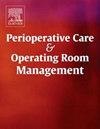从局部阻滞到术后结局:探讨胸外科术中低血压与术后短期预后的关系
IF 1
Q2 Nursing
Perioperative Care and Operating Room Management
Pub Date : 2025-07-29
DOI:10.1016/j.pcorm.2025.100534
引用次数: 0
摘要
视频辅助胸外科手术(VATS)具有并发症少、住院时间短等优点,但术后疼痛仍然是一个挑战。虽然胸椎硬膜外阻滞(TEB)曾经是标准,但对风险的担忧已将注意力转移到胸椎旁阻滞(TPVB)和竖脊平面阻滞(ESPB)上。本研究比较了ESPB和TPVB,重点关注术中低血压(IOH)及其对血流动力学稳定性的影响。在这项单中心、前瞻性、安慰剂盲法试验中,50名选择性VATS患者被随机分为两组,一组在T5时接受假TPVB伴活性ESPB或假ESPB伴活性TPVB。主要结局是IOH,定义为从诱导到切口收缩压降低20%。次要结局包括去甲肾上腺素的使用、恶心和呕吐以及手术持续时间。统计学分析采用卡方检验和配对t检验(p <;0.05)。在分析的47例患者中,ESPB组14例发生IOH, TPVB组12例发生IOH (p = 0.671)。只有3次需要去甲肾上腺素灌注,表明术中严重或难治性低血压的发生率较低。恶心和呕吐无显著差异,而TPVB比ESPB所需时间明显更长(p = 0.025)。ESPB似乎是VATS中TPVB的可行替代方案,提供了一种技术上更简单的方法,而不会影响术中血流动力学稳定性。然而,为了充分了解ESPB的机制和临床意义,还需要进一步的大样本量的研究。本文章由计算机程序翻译,如有差异,请以英文原文为准。
From regional blocks to postoperative outcomes: Exploring the correlation between intraoperative hypotension and short-term postoperative outcomes in thoracic surgery
Video-assisted thoracic surgery (VATS) provides benefits such as fewer complications and shorter hospital stays, but postoperative pain remains a challenge. While thoracic epidural block (TEB) was once the standard, concerns over risks have shifted interest toward thoracic paravertebral block (TPVB) and erector spinae plane block (ESPB). This study compares ESPB and TPVB, focusing on intraoperative hypotension (IOH), and its impact on hemodynamic stability. In this single-center, prospective, placebo-blinded trial, 50 elective VATS patients were randomized to receive either sham TPVB with active ESPB or sham ESPB with active TPVB at T5. The primary outcome was IOH, defined as a 20 % decrease in systolic blood pressure from induction to incision. Secondary outcomes included norepinephrine use, nausea and vomiting, and procedural duration. Statistical analyses were performed using chi-square and paired t-tests (p < 0.05). Among 47 analyzed patients, IOH occurred in 14 patients in the ESPB group and 12 patients in the TPVB group (p = 0.671). Norepinephrine perfusors were required on only three occasions, indicating a low incidence of severe or refractory intraoperative hypotension. Nausea and vomiting showed no significant differences, while TPVB took significantly longer to perform than ESPB (p = 0.025). ESPB appears to be a viable alternative to TPVB in VATS, offering a technically simpler approach without compromising intraoperative hemodynamic stability. However, further studies with larger sample sizes are necessary to fully understand ESPB’s mechanisms and clinical implications.
求助全文
通过发布文献求助,成功后即可免费获取论文全文。
去求助
来源期刊

Perioperative Care and Operating Room Management
Nursing-Medical and Surgical Nursing
CiteScore
1.30
自引率
0.00%
发文量
52
审稿时长
56 days
期刊介绍:
The objective of this new online journal is to serve as a multidisciplinary, peer-reviewed source of information related to the administrative, economic, operational, safety, and quality aspects of the ambulatory and in-patient operating room and interventional procedural processes. The journal will provide high-quality information and research findings on operational and system-based approaches to ensure safe, coordinated, and high-value periprocedural care. With the current focus on value in health care it is essential that there is a venue for researchers to publish articles on quality improvement process initiatives, process flow modeling, information management, efficient design, cost improvement, use of novel technologies, and management.
 求助内容:
求助内容: 应助结果提醒方式:
应助结果提醒方式:


